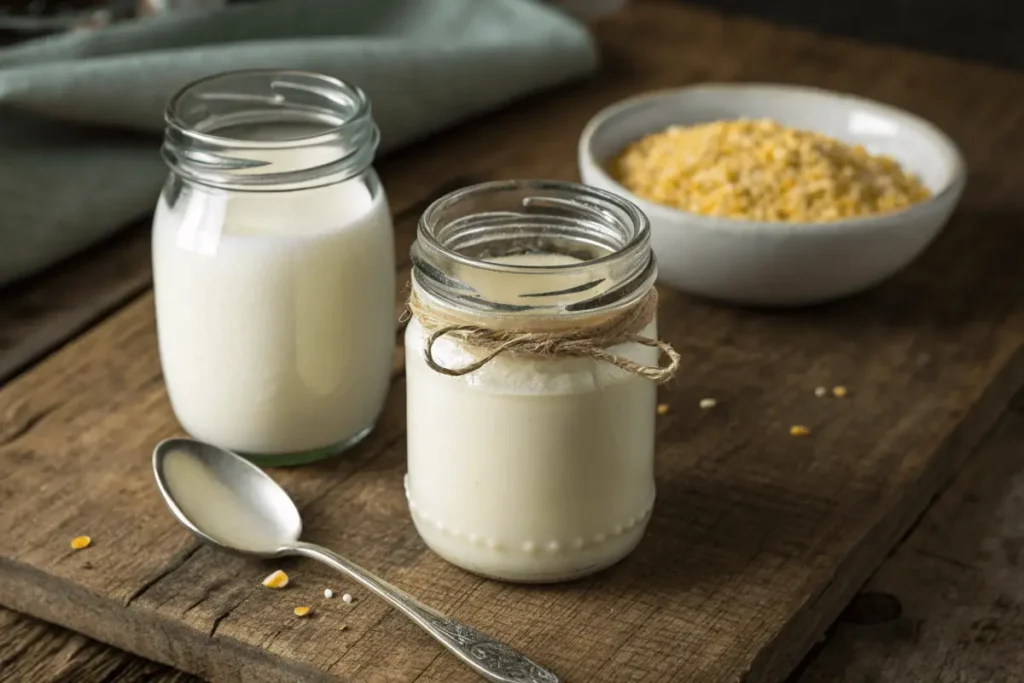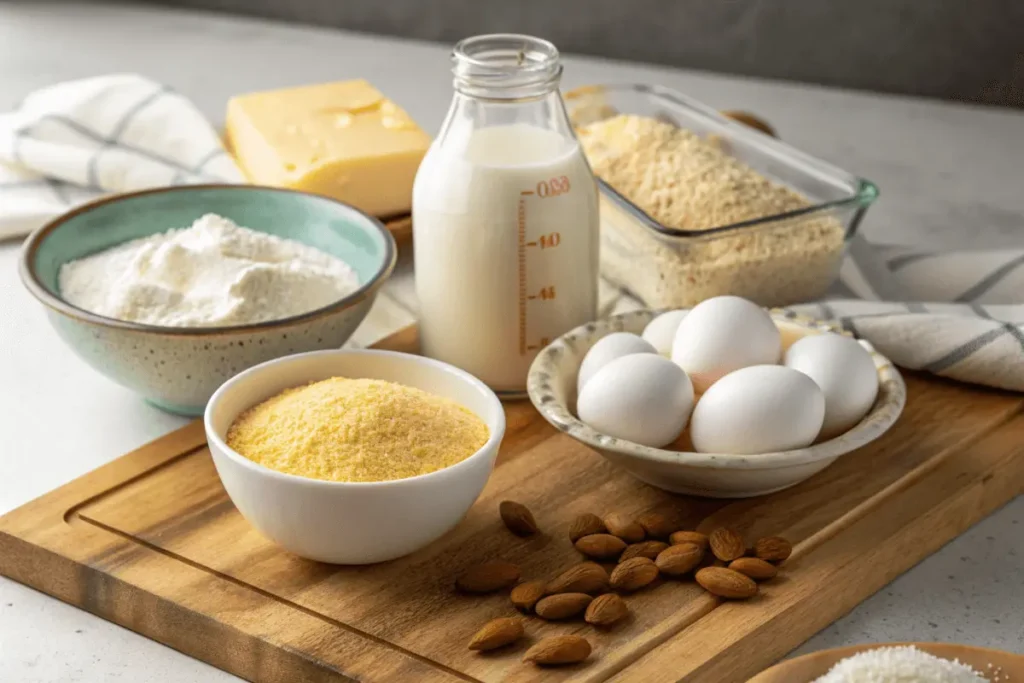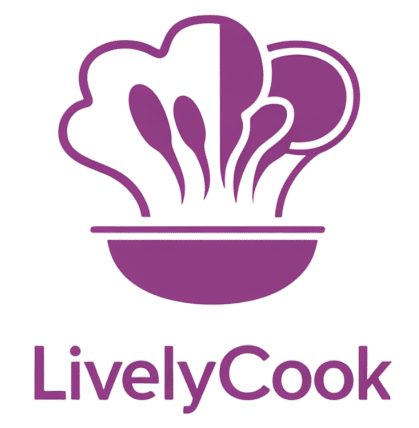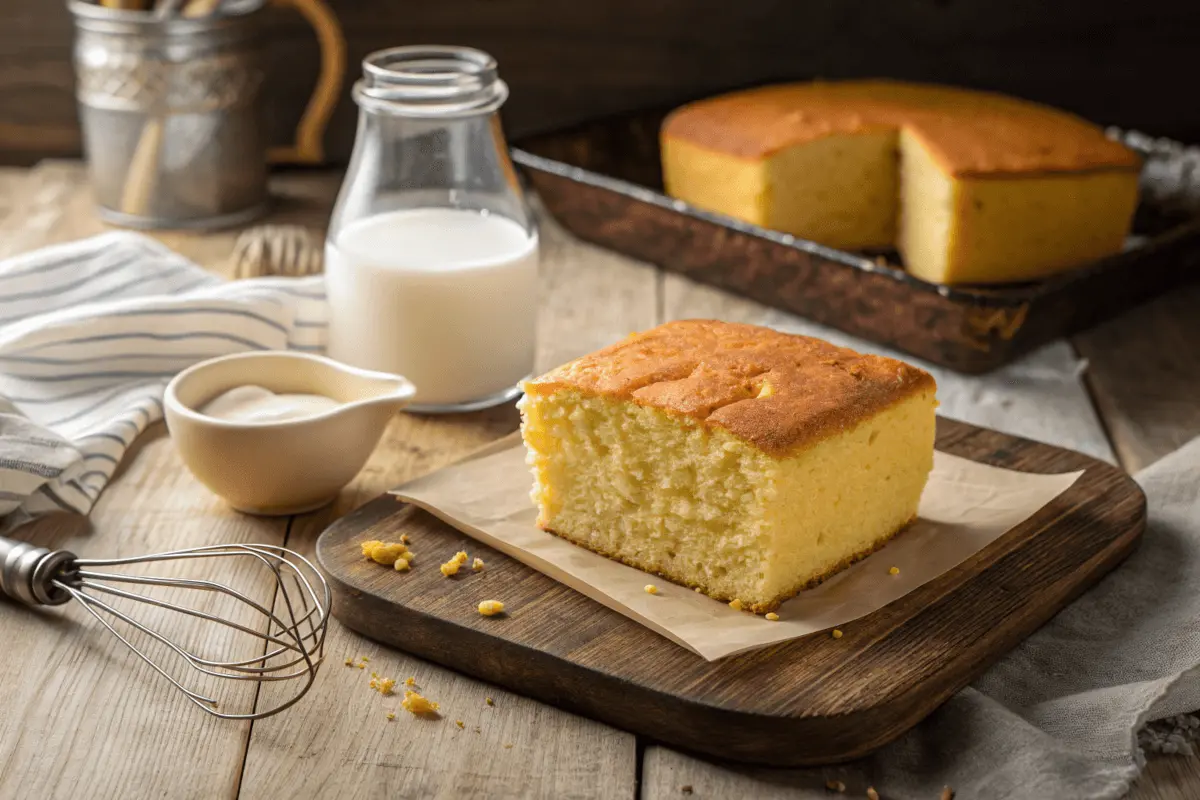Cornbread, a beloved staple in American cuisine, has sparked a timeless debate: is it better to use buttermilk or milk in cornbread? The liquid ingredient you choose significantly influences the flavor, texture, and overall quality of this comforting dish. From enhancing tanginess to maintaining simplicity, the choice between buttermilk and milk offers endless possibilities. In this article, we’ll explore their differences, benefits, drawbacks, and practical tips to help you decide which ingredient best suits your cornbread recipe. Let’s dive in!
Introduction to Cornbread and Its Ingredients
Cornbread is more than just a side dish; it’s a culinary tradition with deep roots in Southern cooking. Known for its golden crust and soft interior, this classic bread is a favorite accompaniment to hearty stews, BBQs, and savory meals.
What is Cornbread?
Cornbread is a quick bread made with simple ingredients like cornmeal, flour, eggs, and a liquid base. While it might seem straightforward, each ingredient plays a crucial role in achieving that perfect crumb and flavor. The type of liquid used—buttermilk or regular milk—can transform the taste and texture of your cornbread.
Role of Liquid Ingredients in Cornbread
The liquid in a cornbread recipe is vital for binding the dry ingredients and creating a smooth batter. But it does more than that—it affects the final flavor, moisture level, and even the bread’s rise. Buttermilk, with its tangy flavor, can give cornbread a richer taste and a fluffier texture. On the other hand, milk offers a neutral base, perfect for highlighting other ingredients in the dish.
Whether you’re after a traditional, moist cornbread or something with a modern twist, the liquid you choose sets the stage for your masterpiece. Understanding the nuances between buttermilk and milk is the first step in perfecting this iconic bread.
Exploring the Differences Between Buttermilk and Milk
When considering whether buttermilk or milk is better for cornbread, it’s crucial to understand the unique characteristics of each. Both liquids bring something special to the table, influencing the flavor and texture of your final dish.

What is Buttermilk?
Buttermilk isn’t just any liquid—it’s a culinary star with a tangy, acidic kick that can elevate your cornbread. Traditionally, buttermilk was the liquid left behind after churning butter, but modern versions are often cultured milk with added bacteria for acidity. This tanginess works wonders in cornbread by creating a moist, tender crumb that melts in your mouth.
Moreover, the acidity in buttermilk reacts with leavening agents like baking soda, helping the bread rise more effectively. The result? A fluffy, light texture that’s hard to achieve with regular milk. If you’re after a rustic, Southern-style cornbread, buttermilk is a fantastic choice.
Key Characteristics of Regular Milk
On the flip side, regular milk is a kitchen staple that offers versatility and simplicity. It has a neutral flavor profile, which lets other ingredients—like cornmeal—shine through. Using milk results in a lighter, less tangy cornbread, perfect for those who prefer subtle flavors.
While milk doesn’t have the same acidity as buttermilk, it’s an excellent option for recipes that focus on balancing sweetness or incorporating unique ingredients like honey or jalapeños. If you’re making a sweeter cornbread or catering to picky eaters, milk might be your best bet.
Understanding these differences lays the groundwork for choosing the liquid that best suits your recipe and taste preferences.
Benefits of Using Buttermilk in Cornbread Recipes
There’s a reason why buttermilk is a go-to ingredient in many traditional cornbread recipes. From enhancing flavor to improving texture, it’s the secret weapon for creating memorable baked goods.
Flavor Enhancement with Buttermilk
One of the standout features of buttermilk is its tangy flavor. This slightly acidic taste adds depth to cornbread, balancing the sweetness of cornmeal and other ingredients. If you’ve ever bitten into a piece of cornbread and been struck by its complex, savory flavor, chances are it was made with buttermilk.
This tanginess isn’t overwhelming—it’s subtle enough to complement a variety of dishes, from smoky BBQ to spicy chili. For those who love bold flavors, buttermilk cornbread delivers a mouthwatering experience.
Texture Improvements with Buttermilk
Buttermilk isn’t just about flavor; it’s also a texture game-changer. Its acidity tenderizes the batter, resulting in a softer, more delicate crumb. Whether you prefer your cornbread crumbly or cake-like, using buttermilk can make a noticeable difference in moisture levels.
Additionally, the acidity in buttermilk enhances the leavening process. When combined with baking soda, it creates air pockets that help the bread rise, producing a light, airy texture. No more dense, heavy cornbread—buttermilk ensures every bite is as fluffy as it is delicious.
Improved Browning and Crust Development
Another benefit of buttermilk is its impact on crust color. The natural sugars in buttermilk caramelize during baking, giving your cornbread a beautiful golden-brown hue. This crust isn’t just visually appealing—it adds a satisfying crunch that contrasts perfectly with the soft interior.
If you’re curious about more Southern-style cornbread tips, check out Lively Cook’s Southern Cornbread Recipe for inspiration!
With its robust flavor and texture-enhancing qualities, buttermilk remains a top choice for cornbread lovers who want to take their baking to the next level.
Downsides of Using Buttermilk in Cornbread Recipes
While buttermilk is often praised for its ability to enhance flavor and texture, it may not be the ideal choice for every cornbread recipe. There are a few potential downsides to keep in mind before deciding whether it’s the right ingredient for you.
Does Buttermilk Require Recipe Adjustments?
When using buttermilk, you might need to tweak your recipe slightly. Its acidity requires a balancing agent—usually baking soda—to ensure the bread rises properly. Forgetting this adjustment could leave you with a dense, flat cornbread. Additionally, buttermilk’s thicker consistency can make your batter harder to mix, so you might need to dilute it with a small amount of water or adjust the liquid ratios.
These modifications might seem minor, but they can affect the ease and consistency of your recipe, especially if you’re a novice baker. If you prefer straightforward cooking without extra steps, regular milk may feel like the simpler option.
Taste Considerations: Is Buttermilk Always the Best Choice?
Not everyone enjoys the tangy flavor of buttermilk. For some, its distinct taste can overpower the subtle sweetness of cornbread. If you’re cooking for a crowd, it’s worth considering whether this bold flavor might clash with other dishes on the menu.
That said, buttermilk is an excellent option for traditional Southern-style cornbread, where its tanginess is a celebrated feature. If you’re looking for inspiration, check out Lively Cook’s guide on Southern Cornbread Recipes to discover more about this style.
Why Milk Might Be a Better Option for Cornbread
For those who prefer a milder flavor and a simpler approach, milk is often the go-to choice for cornbread. While it may lack the tanginess of buttermilk, it offers several benefits that make it a reliable option.
When Milk Is the Right Choice for Cornbread
Milk is a staple ingredient in most kitchens, making it an accessible and convenient choice. Its neutral flavor ensures that other ingredients—like the sweetness of cornmeal or the kick of jalapeños—take center stage. Using milk also requires fewer adjustments, so it’s perfect for quick, hassle-free baking.
If you’re new to making cornbread or prefer a more traditional flavor, milk can help you achieve a classic, balanced result. It’s particularly well-suited for sweeter cornbread recipes, as it allows the sugar or honey to shine without interference.
Is Milk Better for Beginners in Cornbread Recipes?
Milk is ideal for recipes where subtlety is key. If you’re making cornbread for kids or guests with diverse taste preferences, its mild flavor is less likely to polarize opinions. It’s also a great choice if you’re serving cornbread alongside dishes with bold flavors, like spicy chili or tangy BBQ.
For more ideas on using milk in cornbread and other recipes, browse Lively Cook’s array of helpful guides and tips. They provide fantastic resources for beginners and seasoned cooks alike.
In summary, is it better to use buttermilk or milk in cornbread? The answer depends on your preferences and the recipe you’re creating. While buttermilk offers richness and tanginess, milk provides simplicity and neutrality. The choice is yours—experiment and enjoy the delicious journey of finding your favorite!
Exploring Alternatives to Buttermilk and Milk in Cornbread
When exploring is it better to use buttermilk or milk in cornbread?, it’s also worth considering alternative options. Whether you’re avoiding dairy, experimenting with flavors, or working with what’s in your pantry, there are plenty of substitutes to choose from.

Other Dairy Alternatives
If you’re out of buttermilk or milk, other dairy products can step in to save the day. Plain yogurt, for example, is a fantastic substitute for buttermilk. Its creamy texture and tangy taste closely mimic buttermilk, though you might need to thin it with a bit of water to match the consistency.
Sour cream is another option, providing a rich, velvety crumb. However, like yogurt, it may need to be diluted for best results. Reconstituted buttermilk powder, often found in the baking aisle, is an easy alternative too—just mix it with water according to package instructions.
Plant-Based Milk Alternatives
For those avoiding dairy, plant-based milks like almond, soy, or oat milk are popular choices. While these alternatives lack the tanginess of buttermilk, they can still create a delicious cornbread. Be mindful that some plant-based milks have distinct flavors—almond milk adds a nutty note, while soy milk is more neutral.
To mimic the acidity of buttermilk, consider adding a tablespoon of vinegar or lemon juice to your plant-based milk before using it. This simple trick brings a slight tang and improves the bread’s rise.
Non-Dairy Are There Dairy-Free Tangy Substitutes?
For recipes that don’t rely on milk or buttermilk, water can sometimes work in a pinch. However, to boost flavor, try incorporating broth, coconut milk, or even mashed vegetables like pumpkin. These options can create a unique twist on traditional cornbread.
Experimenting with alternatives opens up a world of possibilities, letting you customize cornbread to suit dietary needs and personal preferences.
Practical Tips for Choosing Between Buttermilk and Milk
Choosing between buttermilk and milk isn’t always straightforward. Several factors, from flavor preferences to recipe goals, come into play. Here’s how to make the best choice for your cornbread.
Consider Your Recipe’s Goals
The first step is to think about the flavor and texture you’re aiming for. If you want tangy, moist, and tender cornbread, buttermilk is the way to go. It’s perfect for traditional recipes or when paired with savory dishes like chili or barbecue.
On the other hand, if simplicity is your priority, milk offers a reliable, no-fuss option. Its neutral taste works well in sweeter recipes or when serving cornbread alongside bold, flavorful mains.
Adapting Recipes with Ease
Switching between buttermilk and milk can be simple with a few adjustments. When using buttermilk instead of milk, add a teaspoon of baking soda to balance its acidity. Conversely, if substituting milk for buttermilk, include a tablespoon of vinegar or lemon juice to mimic the tang.
For plant-based or alternative options, always test the batter’s consistency. Thicker liquids like yogurt may require a splash of water, while thinner ones like almond milk might need less to avoid over-thinning.
Ultimately, the answer to is it better to use buttermilk or milk in cornbread? depends on your taste and the occasion. With a little experimentation, you’ll discover the perfect liquid for your perfect cornbread. Enjoy the process, and don’t be afraid to try something new!
FAQs Section
If you’re still wondering is it better to use buttermilk or milk in cornbread?, these frequently asked questions might help you make the right decision. Let’s dive into some common queries to clear up any confusion.
Does Buttermilk Make Cornbread Denser?
Not exactly. While buttermilk adds moisture and a rich tang, its acidity interacts with baking soda to help the cornbread rise. This reaction can result in a light, fluffy texture rather than a dense crumb. However, if the recipe lacks enough leavening agents or if the batter is overmixed, the bread might still turn out heavy.
What If I Don’t Have Buttermilk?
No buttermilk? No problem! You can easily create a substitute by adding a tablespoon of vinegar or lemon juice to a cup of milk. Let it sit for a few minutes, and you’ve got a tangy alternative. For plant-based bakers, this trick works just as well with almond or soy milk.
Can I Use Flavored Plant-Based Milk?
Yes, but be cautious. Vanilla-flavored almond milk or sweetened soy milk might alter the taste of your cornbread, making it sweeter or masking its traditional flavor. If you want to stick close to the classic taste, opt for unsweetened, plain versions of plant-based milks.
How Does Buttermilk Impact Rising?
Buttermilk’s acidity is a game-changer for rising. It activates baking soda, creating air bubbles that make the cornbread tender and airy. If you’re switching from milk to buttermilk, remember to adjust your leavening agents to maximize this effect.
Conclusion: Final Thoughts on Buttermilk vs. Milk
The debate over is it better to use buttermilk or milk in cornbread? ultimately comes down to your personal preferences and the recipe at hand. Both options have their own strengths, and the best choice depends on what you’re looking for in your cornbread.
Choosing Based on Personal Preferences
If you love tangy, moist cornbread with a traditional flair, buttermilk is the way to go. Its ability to enhance flavor, improve texture, and create a golden crust makes it a favorite for many bakers. On the other hand, if simplicity and a neutral flavor are your priorities, milk offers a dependable and versatile alternative.
Experiment and Enjoy the Journey
Whether you stick with the classic or venture into alternative options, making cornbread is all about experimenting and finding what works for you. Don’t hesitate to try different liquids, tweak recipes, and tailor the ingredients to your taste.
In the end, the answer to is it better to use buttermilk or milk in cornbread? is entirely up to you. Each option has its unique charm, so have fun discovering the perfect combination for your next batch of this comforting, timeless bread. Happy baking!

